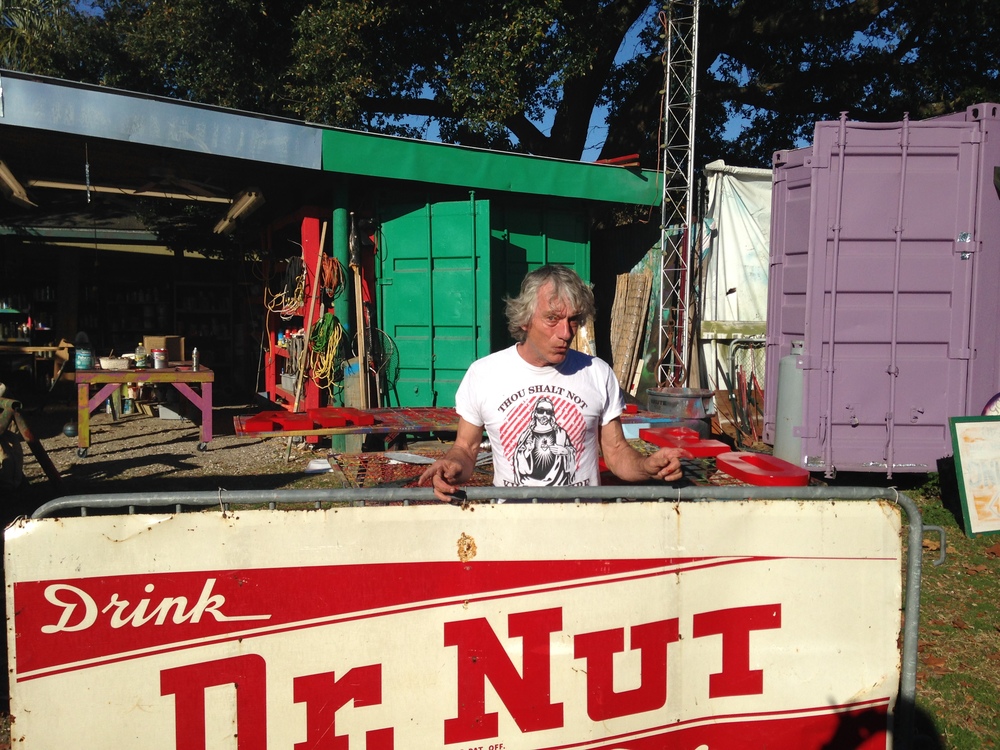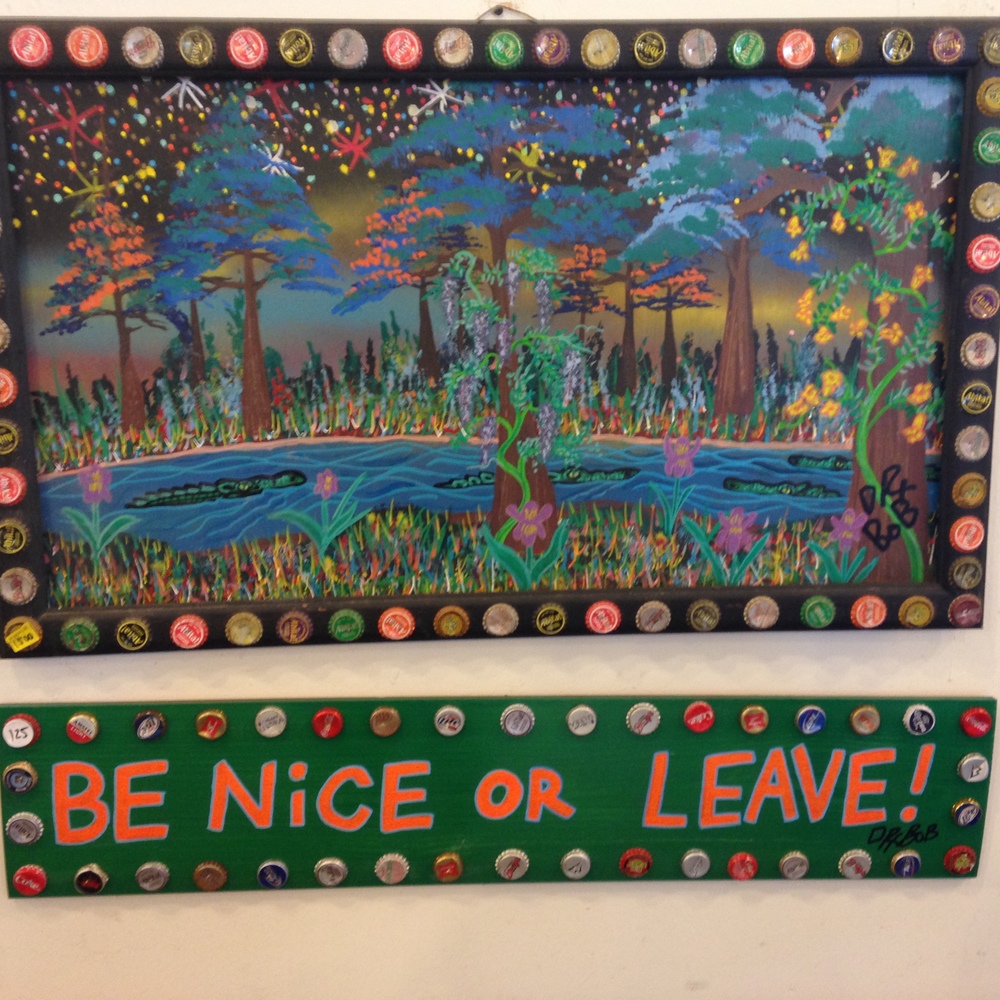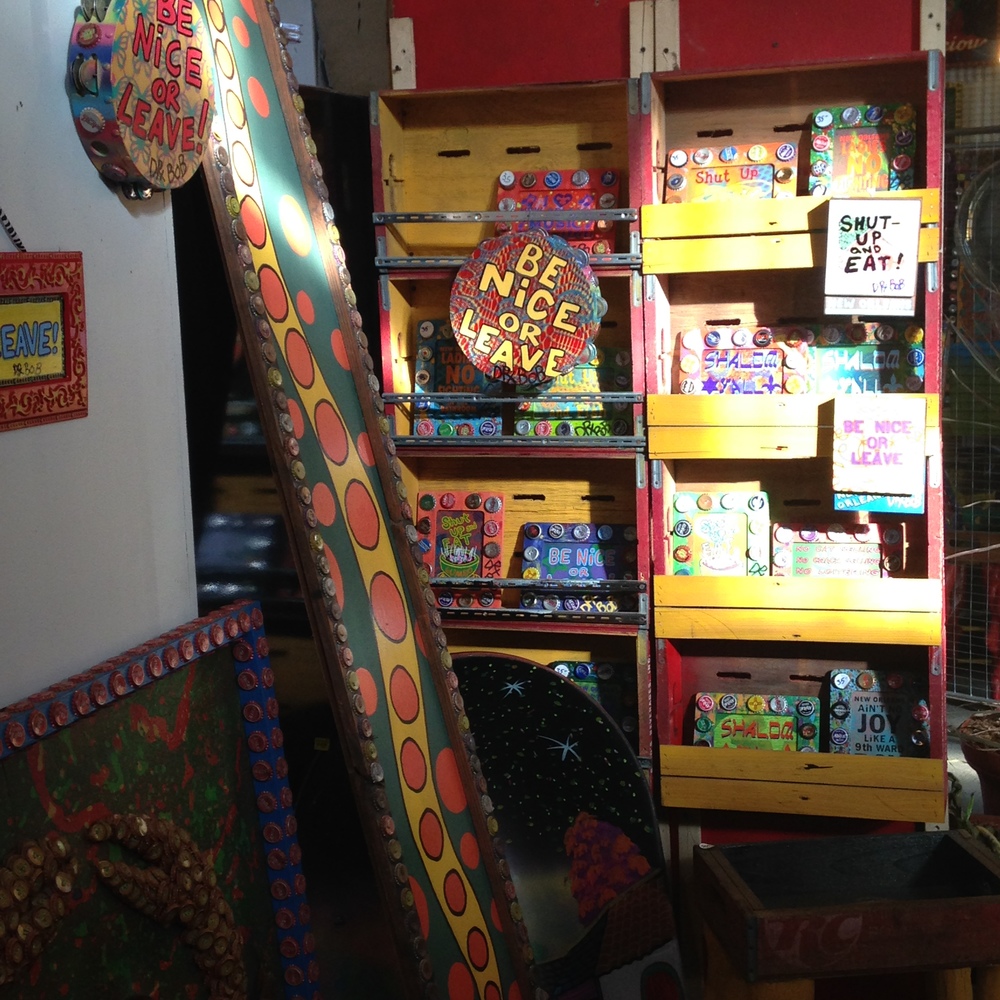The Working Man's Pair-a-dice was a funky little juke joint in St. John, Louisiana. There were red and white dice painted on the front of the building, and the walls inside were turquoise. The bar was open most of the time, but if you wanted to order a screwdriver, you'd get a can of Donald Duck orange soda, a bucket of ice, and a half-bottle of vodka to mix up yourself. If you wanted to order a Bloody Mary, you'd get a can of tomato juice, a bucket of ice, and—you guessed it—a half bottle of vodka to mix up yourself. There was no AC. The Sheriff of St. Tammany Parish could be found gambling in the back, and Edgar, who ran the place, kept a steady stream of fried chicken going to keep folks satisfied while they lost their shirts on the slots.
But if you didn't want to be nice, you'd have to leave.
Edgar said so, right there on a sign at the door. On the back of the sign, things were clarified. "There's nothing in the world worth getting shot over," it said.
Robert Schaffer grew up looking at that sign. He was underage, but it was a Black bar and he was a White boy, so folks looked the other way. He'd sit in the bar and listen to the music and drink the beer. He'd look at the sign and watch the people be nice to one another.
Years later, a grown man living in New Orleans, Robert made a sign like that himself. He hung it on his door in the French Quarter, and it got stolen so many damn times that he realized he might as well go into business.
***
A quarter mile from the Mississippi River and a few blocks east of the Riverfront Streetcar line sits the New Orleans House of Blues. It's a chain, but this chapter is particularly strong. The blues may have first wailed in the Mississippi Delta, but they flowed down the river real quick. We do that music right.
Nationally, the House of Blues is known for some good acts (and high covers), but it also declares itself the largest curator of "Outsider Art" in the world. The Houses are decorated to look like old juke joints themselves, and they're facto folk art galleries. Each one features a local artist, and in New Orleans, you'll see the work of a quirky, well-loved local—Robert Schaffer, known here as "Dr. Bob." He's known for his paintings on signboards, planks and tin sheets, as well as his hand-carved wooden alligators. His work is all over the House.
Bob's most famous signs, a nod to Edgar, read, "Be Nice or Leave." In some neighborhoods, you'll see one in every other restaurant and store. The sentiment and its cousins, "Be Gay and Stay" and "Shalom, Y'all," seem just right for the House of Blues, whose goals include promoting "racial and spiritual harmony through love, peace, truth, righteousness, and non-violence."
Maybe "Be Nice or Leave" could be the new world order. Maybe it could be the mantra of our international governing bodies—the UN to Syria, "Be nice or leave," NATO to Russia, "Be nice or leave." Maybe the signs are the perfect call for peace.
But Bob's language is a tougher call. If you're a White person (even one who makes clear that she's reporting), there's a high likelihood that Dr. Bob will throw the n-word into conversation by the five-minute mark. The second time he said it, I pointed it out. "But the Black guys call me all sorts of things!" Bob explains "like Cracker, and Honky!" I'm not sure it's an even trade.
***
The first time I went to interview Dr. Bob, he wasn't around. There is a furniture workshop that shares the lot with his studio. A young man was unloading planks from a pickup.
"Looking for Bob?" he asked.
I was. The signs said open, so I had figured he might be in.
"Try again tomorrow—I don't think he's home."
When I tried again tomorrow, I met Bob's assistant. She let me know that Dr. Bob was due to arrive from Memphis that evening. He was supposed to come back last week, she said, but the project there was taking a while. He was decorating a whole bar up there, after all. But she gave me Dr. Bob's card with his number on it.
I called the next day, and the line went direct to Dr. Bob's cell. I introduced myself and asked about an interview. He said that'd be just fine, but he was in Memphis.
"I don't know how long I'll be. Maybe tomorrow. The next day. Maybe Sunday? Call me back then. Call then. Sunday."
On Sunday morning, I call—is he around? Does he have time to be interviewed?
"Sure. After lunch," he tells me.
After lunch, I arrive.
"Today's not a good day for an interview," Bob says to me, shaking his head. He's got a little joint hanging out the left side of his mouth, and it swings when he talks.
"Because I'm really tired and I've got to pay rent." He sorts through a pile of checks in his hand—"eleven of them!" he declares—then puts them all in an envelope and walks it outside. "To the rent box."
When Bob returns, I ask if I can just watch while he works.
"IF I work," he says, and motions me to follow him to the 'studio' portions of his shed. We head out through the back to an outdoor workshop underneath a wide tin roof. As Bob re-lights his joint with a blow-torch, I count ten multicolored sawhorses, one bathtub on wheels with a fiberglass panel resting on top, a large wooden alligator, and an electric sanding machine. There are also bottle caps (everywhere), a few generous armfuls of dried seaweed strewn across the bathtub's glass panel, and a bucket full of teeth.
While he works, Bob talks about Memphis and about the all the folks he knows there who knew Elvis. For instance, Elvis had a tailor—who also drove him to church on Sundays and sold him the very suit that he died in. (Or that he's still wandering around in—jury's out.) And Elvis had a neighbor, whose big ol' yard he drove a red Harley Davidson around with his friends. Dr. Bob knows both neighbor-man and tailor-man. He's got connections like that, in Memphis.
It reminds him of New Orleans, a little, and the folks there like his work. "My art's in the damnedest places all over that city," Bob explains. "One's in this Black guy's haberdashery and it just says Get the Fuck." Less notably, perhaps, he also has work up in the Center for Southern Folklore and the Smithsonian affiliate, Memphis Rock 'n' Soul Museum.
Bob's art has met, indeed, with considerable acclaim—his biggest sells are large, mixed-media creations—the big carved alligators (with real alligator teeth and glass-blown eyes!) or the seven-foot-tall bottle-cap monsters in enormous plywood frames. Ellen DeGeneres reportedly owns an original Bob, and word has it that Emmylou Harris, Mariah Carey and Matthew McConaughey do too. Some of his work sells for upwards of $10,000.
But the typical Dr. Bob piece—the kind in the 45 or 50-dollar range—is a small, colorful sign, maybe five by seven inches, with a spunky phrase painted on a bright background. "Be Nice Or Leave" is by far the most popular, but you can also find "Shut Up and Fish," "You bein' watched" and the euphemistic "No Cat Sellin'." Each sign has a border of bottle caps—local ones like Abita and Barq's, but also your average old Miller Lites, your Red Stripes and Cokes.

Beyond the signs, Bob gets creative with cypress knees, because "when nature grows you four table legs, you might as well use 'em," and plays visual puns with his bottle caps. He once made a large metal dog out of Barq's caps.
There are tables made of wheelbarrows and sculptures made with old metal sheeting. There are bottle-cap skeletons and fluorescent-painted gators.
Bob has also painted a number of paintings of scenes from John Kennedy O'Toole's farcical, Pulitzer Prize winning novel, The Confederacy of Dunces. Its main character, Ignatius J. Reilly, a pasty, awkward, bulbous man, is both fed up and enamored with the spirit of New Orleans. Early on in the book, when stopped by a police officer, he fumes at its contradictions:
"Is it the part of the police department to harass me when this city is a flagrant vice capital of the civilized world?" Ignatius bellowed over the crowd in front of the store. "This city is famous for its gamblers, prostitutes, exhibitionists, anti-Christs, alcoholics, sodomites, drug addicts, fetishists, onanists, pornographers, frauds, jades, litterbugs, and lesbians, all of whom are only too well protected by graft."
Contradictions indeed. Reilly's rant is crass and bigoted, but he's neither the first nor the last to read the city's inconsistencies.
It's an understanding that rings particularly true when it comes to race.
I used to work as a sixth-grade teacher, and I once took my class of thirty to a local museum of Louisiana history. Our tour-guide, an older White lady—maybe seventy or so—smiled at my students.
"Now," she explained, as if she were ready to hand each child a freshly baked cookie, "you all would've been treated pretty well here in Louisiana. We were really kind to our slaves!"
My students were nonplussed.
"In fact, you would've had Sundays off! That's how your people started playing music here in this city. On Sunday, all the slaves gathered in Congo Square and played music. That's why New Orleans is the birthplace of jazz!"
My students stared at their sneakers, and I began to regret the lecture I'd given them ten minutes before on the importance of kindness to tour guides.
There she was, patting my students on the back, complimenting them, telling me how they were just the best class she'd had all year! Just an hour after telling them about the great lives they'd have enjoyed as property. But our docent isn't an outlier.
Walk to Jackson Square, which celebrates the president of 20-dollar bills and the Trail of Tears. Come to the base of a Mardi Gras parade at Robert E. Lee Circle, a small park dedicated to the famed defender of slavery. (Today, Lee's statue sits high in the park's center and casts shadows on the grass where our homeless city residents camp out during the day.)
Watch a sign appear in a local bar a year after a neighborhood diversifies. "No hoodies. No sneakers. No gold necklace chains. No baseball caps. No white undershirt tank tops. No baggy jeans. No revealing clothing on ladies." Then watch a crowd of White Tulane students sail through the door dressed in sweatshirts and Saints caps, miniskirts and heels. Hear them hum along to Louis Armstrong and Wynton Marsalis recordings when they get inside.
Go to Lusher, the highest-performing public school in the city, and read the section of their mission statement on "individuality and diversity." Then observe, in a city that's 60 percent Black, the four White students that pass you for every student of color you see in the hall.
And Dr. Bob has lots of Black friends. Even in the old days of childhood—simpler times, "when you could run around having fun with swastikas on your arm, just playing Nazis in the backyard without it meaning racial hatred"—Bob had Black friends. All the kids played together in the neighborhood. They just had to split up to go to school and drink at the water fountain. And he dated "kind of a Black girl in the sixties, during the integration stuff."
Bob also has two Black friends from Memphis, where he lived briefly. He wants to tell me about two that he met on his first day in the tenement buildings downtown.
"The day the Black guys in Memphis met me, I showed up with all my worldly possessions to these tenement buildings, with my ninth-war warrior shirt and my guns and my shiny shoes on. And I'm wearing a rebel hat on it with a pin that said 'Love,' and I was listening to Marvin Gaye. And they were like, 'Who the fuck is this wigger?'"
It was the start of a beautiful friendship.
"We got tight. We'd go out and fuck off—we'd go to this Bonanza Steakhouse in West Memphis and watch the big fat White men at their troughs."
"Occasionally we'd have some sort of ethnicity with us, at our choosing, an Asian person or a Russian, a Czechoslovakian. People in the service industry. We'd all just hang out and watch these rednecks with their pearl buttons."

Here in New Orleans, Dr. Bob's circle of friends remains multiracial.
Bob is good buddies with Mr. Arthur Robinson, whom the city knows as "Mr. Okra." Like his father before him, Mr. Okra drives through the city on a beaten-up truck and announces his daily produce for sale through a loudspeaker.
"I have oranges and bananas," he sings, "I have cantaloupes and pineapples." (This particular tune, and Mr. Okra himself, were profiled in a documentary that made waves at both Sundance and Cannes last year.)
A few years back, Mr. Okra's truck broke down and wouldn't start up again. Money was tight, and he was still struggling to rebuild his home post-Katrina. Dr. Bob was among the cadre of locals who pitched in to help. After musicians held benefit concerts to buy a new pickup, Dr. Bob painted it for free in his signature style. True to Mr. Okra's song, Bob has painted oranges, bananas, cantaloupes and pineapples on all sides of the pickup, and the truck warns buyers to "Be Nice or Leave" in bright block letters in the curving metal above both front wheels.
And the boys in the neighborhood treat Bob as something of an uncle. Little ones come by to show off their drawings and get rides on the back of Bob's truck. Older boys come and talk and make presents for their girlfriends and smoke. One afternoon, Bob and I are upstairs in his "office," a little window-walled room up some stairs that looks down on the studio floor. A young man, (whom I'll call Freddy to preserve his privacy), dreadlocks hitting his rear, yelled from down below.
"Bob?"
Bob rolls his rolly chair to the door of his office and peeks out.
"Freddy!"
"Hey Bob," Freddy said.
"Come on up!"
Freddy comes on up and sits on the last remaining rolly chair (I scoot mine up to shake his hand hello).
They smoke together and talk about life. Bob tells us about prison.
Before integration, Bob was in jail for a quick minute and it was pretty okay. But things aren't the same today.
"It's fucking insanity now," he tells us. "A White person can't take it to be thrown up in in Orleans Parish Prison. It's just a fucking zoo. The Blacks run it. It's like having giant football players all around and they'll just squash your ass. They'll have you killed, have you shanked, have you smothered—fuck. And it's still nasty and fucked up from the storm in there. Dirt and shit and crud all over the walls in that place."
Freddy and I nod.
"Still planning on college in the fall?" Bob asks.
"Yes."
"That's good man, that's good. Don't lose that. How's your mama?"
"She's good—been tired lately."
"You tell her I say hi."
"Will do," Freddy says.
Freddy leaves when I leave, but I don't have the courage to ask how he feels about Dr. Bob's choice of language. I don't know that it's my place to ask.
***
Dr. Bob also paints mojo hands. In real life, a mojo hand isn't a literal hand that you'd give high-five with. It's a handful, really: a small flannel bag filled with tokens and talismans aimed, in the Voodoo tradition, to bring good luck. But Dr. Bob painted his own version. On a wooden board, bordered with a wooden frame and bottle caps, there's a bright yellow hand with an eyeball in the middle. On each finger, Bob's written the name of a different type of local music—the pinkie for gospel, ring for blues, middle for zydeco, pointer for Cajun, and the thumb for jazz.
It's a palm of our city's rich culture. The Mojo hand's voodoo, like blues and gospel and jazz, has roots in the African-American community. New Orleans is known for and celebrates this. We have a Jazz Fest, a Voodoo Fest, and a tradition of Gospel Brunches. But the city's most famous tradition has a less welcoming history. It took until 1992 to enforce that all Mardi Gras Krewes (pricey social clubs that host the different parades each year) accept Black folks. Still today, Rex and Bacchus, two of the largest parades, are nearly all White, except for the members of high school bands, who are Black—and the Flambeaux, men who carry tall flaming crosses for light as the parades dip into evening.
The Flambeaux were originally slaves, but today they're often low-wage workers, bolstered by the maybe 50 dollars a Krewe will pay them to march eight or so miles carrying many pounds of flaming weight. Crowds are encouraged to support the Flambeaux by throwing small change at them. Extra if they dance. Or dip and swirl with the torch, the fire sometimes catching their skin.
The parade-goers hurl quarters and dimes at the men's feet and feel like they are being nice.

